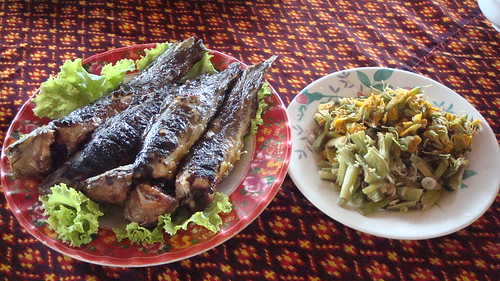CIvitGñkERs
RBlwmsVagrHRBHsuriya bkSIbkSaERskrMBgéRB
GñkmþayrUtrHerobmðÚbcMn I É´XµatxµIcab;TwmreTH.
«BukeRbI´eGayykngÁl½ erobcMRsYlbYlRKb;sMPar³
ritcgCab;lab;eRBaHxøacFøak; xUcxatsMPar³begáInpl.
rUb´cab;epþImcgemeKajI naMykeTATIvalERsCayPUmi
cgvaBIeRkayeQµalFM² rYcedjgMu²sMedAERs.
éf¶rHeXIjc,as;TIvalERs rUtrHmñImñarTwmngÁl½
cab;eKacUlnwmehIyRsYlbYl rkTIvalRsYlcgemjI.
Bukcab;epþImP¢ÜreBleTAdl; mincaMnaMxVl;eRBaHRbjab;
GagP¢ÜrehIyras;dak;kNþab; rayvaeGayRsab;sÞÚgeBléf¶.
P¢ÜrehIyras;ehIyTIs¥ateRsc ´raykNþab;eGayGñksÞÚg
eRBaHERsmYyenHvaFMlµm eGayeKsÞÚgbegðIymYyéf¶.
eGanegIb²sÞÚgehIyeRsc mincaM)ac;Tukdl;éf¶Es¥k
´erobcMTukdak;sERgk TukeRsc)ac;erobcMeTApÞH.
CIvitGñkERsval¥mü:ag EteRbIkMlaMght;bnþic
minGIeTenHCalixit Edl)ankMritdl;GñkERs.
fVIt,itEtht;Etsb,ay rs;KµanenIyNaynigGatµa
RBlb;cUleKgKµanLÚLa RBwkeLIgkalNaeTAERseTot.
¬niBnæeday³ehg sMbUr¦
ពន្លកសេ្នហ៏បុប្ថាកំពង់សោម
PBV½eRBgvasnacareGayCYb rUbRss;BnøkkMBg;esam
vg;Pk½þl¥Rss;Rbus²ecam enAkñúgcMenammanrUbbg.
eBleXIrUbRss;RsIdMbUg eFVIeGaybglg;Pk½þklüaN
eBlenaHrUbGUnRss;BMuzan s¶ÜnklüaNcrikkacqñas;.
fVIt,itEtkacEtGUnl¥ rUbRss;bvrl¥elIRsI
manEtGUneTkñúgelakkiy EdlbgebtiysµK½elIGUn.
lMrwkRtYs²Rbvtþiesñh¾ bgCYbmasemtamTUrsB½Þ
sMdIGUnRsYyKYrcg;sþab; pÁÜbnwgsasB½Þénevahar.
evlaéf¶esATI 27 rUbnimlCECknigbg
evlaenaHehIyelIkdMbUg bgnwgmass¶YnCECkKña.
kñúgcitþKYcesñh¾rUbRss;RsI mindwgmanéf¶)anCYbPk½þ
niyayCamYyEtBIrnak; nigrUbvl½kçsarPaBesñh¾.
Rsab;Et»ükas)anmkdl; Nat;CYbnimltamsnüa
evlakEnøgeyIgCYbKña rUbRss;knñifaGñkkMnt;.
CYbelIkdMbUgcrcaKña bgnwgBMugarRtUvrUvNas;
eRBaHCadMbUgén»kas bgnwgvlø½k)anCECk.
niyayRbEhlCaBIrem:ag bgeXIjnwmnYnfal¥Nas;
l¥taMgBIrwktaMgBIrag CamnusSxJúMb:gkñúgsubinþ.
CYbPk½þCMBak;esñh¾elIRsI sUmGUnRbNIdl;kþIesñh¾
manEtGUnmYyKµanTIBIr sµK½esµaHqvIGs;sgçar.
eBlenHminTan;)aneroncb; Etbgsnµt;cUlsþICIva
sUmGUnRbNIdl;eromr:a esñh¾EtknñifaluHéf¶kSy½.
niBnæeday³ ehg sMbUr
ជីវិតកូនប្រុស
TwkEPñkebHdUgcab;epþImRsk; eRBaH)anKitxusedIrpøÚvBal
minsþab;sMdIelakTUnµan eTIbEtPJak;xøÜnfaeFVIxus.
TRmaMPJak;xøÜnesÞIyWteBl Rtlb;bkeRkayvaesÞIhYs
vilmksikSaykcMenH ERkgfanwgecHdUceBlmun.
GVI²hYseBlsÞWTaMgGs; eRBaHedIrpøÚvxusmYyevla
vk;nwgesñhaEl,gBala ePøcfaviC¢aCaRtImux.
dak;citþcUleron)anBIrEx Qb;KitBIesñh¾El,gRsIRsa
evlaRbLgdl;ehIyNa EtkñúgGatµaKµanecHGVI.
cUlrYmRblgbMeBjmux eGayelak)ans¶b;kñugcinþa
KNitnBnçrUbPasa minc,as;mYyNafarUbmnþ.
lTçpl)ak;Dub)anecjmk kñúgcitþesayesakxµas;mitþPkþi
eTaHbIBYkeKmkrak;Tak; lTçplEsþgCak;)anFøak;ehIy.
KitfaxøÜnxJMúKµanpøÚvedIr eRBaHCaGMeBIEdlxøÜnsag
CapltbsñgRKb;Ebby:ag eRBaHEtlMeGogedIrpøÚvxus.
ehtuEtCIvitmanvasna lixit)ancarBIbueBV
eGaypøÚvxJMúedIrKaµnrujra bnþsikSasalafµI.
TIfµIdIfµIénCIvit RBHsIhnuBitTIRkúg
eFVIeGayCIvitRss;pUrpg ; BIPaBeRKaHl¶g;mkviC¢a.
eBlenHerobrab;TukçmþgeTot eRBaHkayRtUvXøatGñkmanKuN
taMgEtBItUcxMEfrs¶ÜÞn \LUvrUbkUnRtUvXøatq¶ay.
muneBlXøatbita)anpþaM kUnRtUvcgcaMBakü«Buk
RtUvxMsikSakMuekkkuk eRBaHKµan«BukenAdas;etOn.
ÉGñkmþayvij)aneBalEfm RtUvxMeroneLIgkMuCinNay
rUbmþay«BukCYyBIcMgay kUnRtUvEfrkayxMsikSa.
kMBtkMBg;esamCitKña ebIrUbs¶ÜnPJanwkBukEm:
kUnGacRtlb;éf¶lMEhr EtBIrem:ageTKWdl;ehIy.
CacugeRkaykUnsUmsnüa eTAGñkTaMgeTVrecjBIcitþ
kUnnwgxMerontamKMnit Edlelak)anKitBImunmk.
eBlenHkarsikSak¾)an cMenHk¾manBIdunbUsáÚ
kUnGaceFVIkar)any:agl¥ GnaKtbvrenAkñúgéd.
enHCamYyEpñkénCIvit EdlCakarBit\tmusa
ecjBIdYgcitþénkUnRbus EdlmankMhusxusBImun.
niBnçeday³ehg sMbUr


































